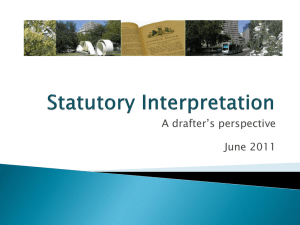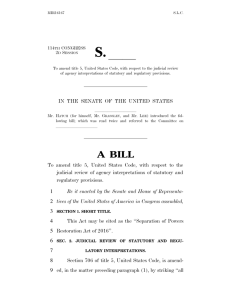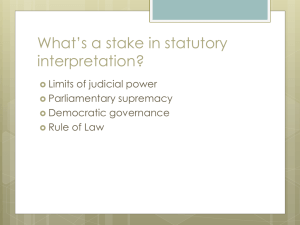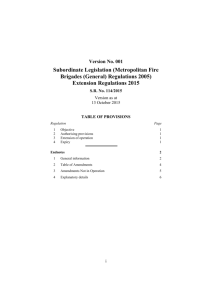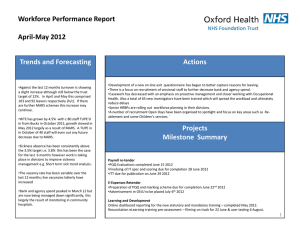Statutory Interpretation for Government presentation
advertisement
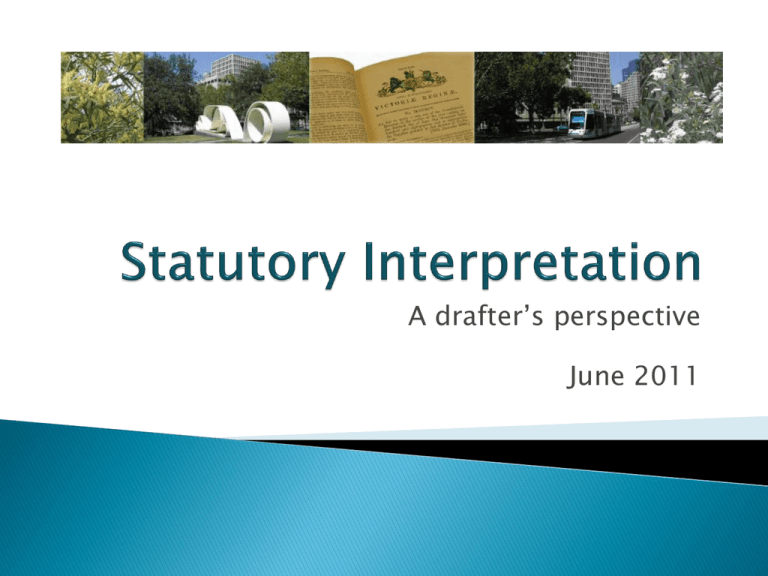
A drafter’s perspective June 2011 Outline The structure of legislation A plain reading A purposive construction The context in which legislation is drafted The statutory context: The application of the Interpretation of Legislation Act 1984 and other Acts of general application Federal constitution The common law context: Case law Some interpretive rules and aids to interpretation The structure of legislation Make sure you have the correct version of the legislation Read the Act as a whole Finding the correct version of an Act www.legislation.vic.gov.au Statute Book (Acts passed and Regulations made in a designated year) Authorised versions and historic Acts Law Today (current consolidated versions of principal Acts and Regulations) Authorised versions and version history Parliamentary Documents (Bills and explanatory memoranda) As sent prints and As passed prints www.ocpc.vic.gov.au www.parliament.vic.gov.au Commencement Book Act and Statutory Rule Tables Lists of current Acts and statutory rules Hansard Information regarding parliamentary process Read the Act as a whole Structure and layout of legislation Chapters, Parts, Divisions, Subdivisions, sections, subsections, paragraphs subparagraphs and subsubparagraphs Numbering conventions Definitions Punctuation Notes and examples Standard or common provisions in Acts Preamble Long title and short title Purpose Objects/Principles Commencement Definitions Binding the Crown Regulation making powers Transitional provisions Self repealing provisions in amending Acts Give the provision a plain reading Look at the context of the provision A Purposive construction Section 35(a) of the Interpretation of Legislation Act 1984 Section 35(a) of the Interpretation of Legislation Act 1984 provides- In the interpretation of a provision of an Act or subordinate instrument: (a) a construction that would promote the purpose or object underlying the Act or subordinate instrument (whether or not that purpose or object is expressly stated in the Act or subordinate instrument) shall be preferred to a construction that would not promote that purpose or object; and Extrinsic aids to interpretation: Interpretation of Legislation Act 1984 section 35(b): (b) and consideration may be given to any matter or document that is relevant including but not limited to— (i) all indications provided by the Act or subordinate instrument as printed by authority, including punctuation; (ii) reports of proceedings in any House of the Parliament; (iii) explanatory memoranda or other documents laid before or otherwise presented to any House of the Parliament; (iv) reports of Royal Commissions, Parliamentary Committees, Law Reform Commissioners and Commissions, Boards of Inquiry or other similar bodies. Statutory context for interpreting legislation Legislation of general application Interpretation of Legislation Act 1984 Charter of Human Rights and Responsibilities Act 2006 Sentencing Act 1991 Criminal Procedure Act 2009 Infringements Act 2006 Monetary Units Act 2004 Constitution Act 1975 Interpretation of Legislation Act 1984 Commencement and repeal of Acts Formal matters relating to Acts Rules of construction (interpretation) of Acts Definitions (s. 38) Saving of Acts and things done under repealed provisions Delegation of powers Matters dealing with the exercise of powers and duties Special provisions dealing with subordinate legislation (including regulations, rules of court and other statutory rules) Charter of Human Rights and Responsibilities Act 2006 Sets out human rights and responsibilities drawn from ICCPR Statements of compatibility Statutory interpretation Supreme Court powers to make declarations Duties of public authorities Sentencing Act 1991 Creation of offences: s. 111 Penalty levels: s. 109 Infringements Act 2006 Issuing and serving of infringement notices and enforcement of infringement penalties for 60 Acts that contain infringement offences Criminal Procedure Act 2009 Section 72 provides that the defendant bears the evidential burden of proof in relation to any exception or excuse to an offence created by statute Monetary Units Act 2004 Sets penalty units and fee units Fixed by the Treasurer by Government Gazette notice Constitution Act 1975 Parliament, Executive, Supreme Court Special and absolute majority requirements Section 85 (jurisdiction of the Supreme Court) Referendum provisions Common law context for statutory interpretation Case law Legal assumptions/rules of construction Presumption against retrospective operation Presumption of Crown not bound by legislation Presumption against alteration of common law doctrines Privilege against self incrimination Legal professional privilege / client legal privilege Acts presumed to be within legislative powers of the State Presumption against extraterritoriality Rule against delegation of legislative power
